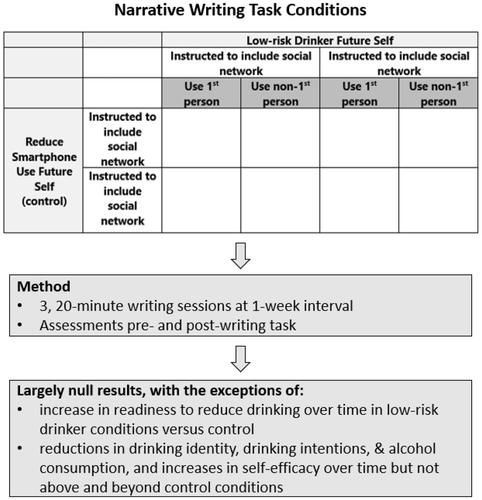Investigating cognitive and motivational proximal outcomes in a randomized clinical trial of writing about the future self to reduce drinking
Abstract
Background
Drinking identity (the extent to which one links the self with drinking alcohol) is a unique risk factor for college students' hazardous drinking that is not directly targeted by existing interventions. We conducted a study that aimed to decrease drinking identity among college students with hazardous drinking. We adapted a writing task about the future self and tested whether three writing sessions could decrease drinking identity and change drinking. We also investigated whether two additional factors (writing perspective and inclusion of participants' social networks) would enhance task impact. The present study evaluated whether posited proximal cognitive and motivational outcomes (drinking identity, self-efficacy, readiness to change, and drinking intentions) changed immediately after each writing session.
Method
The study is a randomized clinical trial in which hypotheses and analyses were pre-registered. Participants were 328 college students who met hazardous drinking criteria. The study had a 2 (narrative writing topic: low-risk drinker vs. reduced smartphone use) × 2 (writing perspective: first-person vs. non-first-person) × 2 (social network instruction: instructed to include vs. not) factorial design. Proximal outcomes were drinking identity, self-efficacy, readiness to change, and drinking intentions. The clinical outcome was alcohol consumption. Participants completed three laboratory sessions at weekly intervals that included the writing task and pre- and post-task assessments.
Results
Results were largely null, except that readiness to reduce drinking was higher in the low-risk drinker condition and increased over the lab sessions. Time effects indicated that reductions in drinking identity, drinking intentions, and alcohol consumption, and increases in self-efficacy were observed but did not change above and beyond control conditions.
Conclusions
Findings indicate the need to strengthen the writing task and select a more appropriate control task to target proposed proximal outcomes. Future studies might try personalizing the task, evaluating its efficacy with individuals motivated to change their drinking, and using a control task that does not involve imagining a future self.


 求助内容:
求助内容: 应助结果提醒方式:
应助结果提醒方式:


